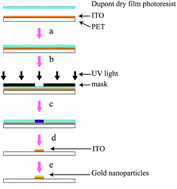A gold nanoparticle-modified indium tin oxide microelectrode for in-channel amperometric detection in dual-channel microchip electrophoresis†
Abstract
A modified indium tin oxide (ITO) microelectrode detector integrated with a dual-channel polydimethylsiloxane (PDMS) microchip is proposed for in-channel amperometric detection in microchip electrophoresis (ME). The gold nanoparticle (GNP)-modified ITO-coated poly-ethylene terephthalate film electrode was fabricated via a photolithography process and direct electrochemical deposition. This electrode fabrication method reduced the cost of this microchip a lot. The electroplating conditions for the GNP-modified ITO electrode were optimized through evaluating the effect on the detection sensitivity and separation efficiency of a dual-channel ME system. Under the optimal conditions, the performance of the new ME amperometric detection system has been demonstrated by analyzing a mixture of p-aminophenol, o-aminophenol and m-aminophenol, which achieved the detection limits of 0.24 μM, 0.41 μM and 0.42 μM, respectively. Finally, the successful detection of antibiotics demonstrated the potential of this dual-channel microchip system for clinical application.



 Please wait while we load your content...
Please wait while we load your content...